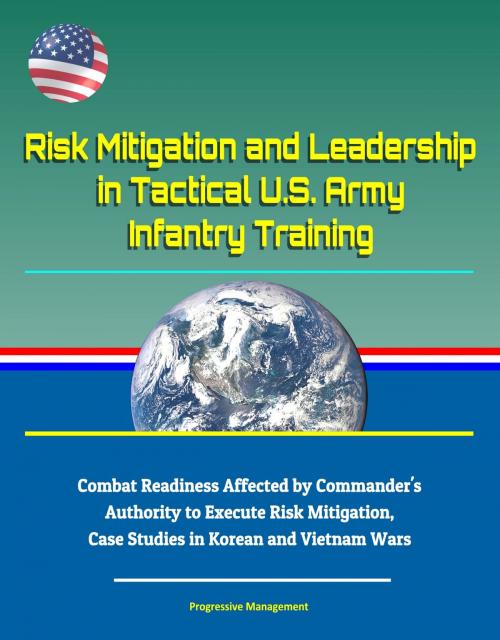Risk Mitigation and Leadership in Tactical U.S. Army Infantry Training: Combat Readiness Affected by Commander's Authority to Execute Risk Mitigation, Case Studies in Korean and Vietnam Wars
Nonfiction, History, Military, Vietnam War, Asian, Strategy| Author: | Progressive Management | ISBN: | 9780463536575 |
| Publisher: | Progressive Management | Publication: | July 7, 2018 |
| Imprint: | Smashwords Edition | Language: | English |
| Author: | Progressive Management |
| ISBN: | 9780463536575 |
| Publisher: | Progressive Management |
| Publication: | July 7, 2018 |
| Imprint: | Smashwords Edition |
| Language: | English |
This important December 2017 report has been professionally converted for accurate flowing-text e-book format reproduction.
Despite the prevalence of irregular wars, the U.S. Army must also be prepared for the possibility of a high-intensity conventional war. The training required for this war must simulate the expected conditions, those of high-intensity conflict, as closely as possible. As U.S. strategic leaders look to the future and prepare the U.S. Army for the next conflict, they prepare for a war with a level of violence that resembles that of the Korean War. While conditions that simulate combat are dangerous and present inherent risks, the mitigation of that risk prevents the adequate simulation of a high-intensity combat situation. Therefore, this thesis studied how risk mitigation practices in U.S. Army tactical infantry training affect Soldiers' preparedness for high-intensity combat operations. By examining U.S. Army infantry training at the tactical level, U.S. Army safety and risk mitigation doctrine, cognitive and perceptual biases, and historical case studies, this thesis suggests that U.S. Army risk management practices neither hinder nor help combat preparedness. Instead, the abdication of a commander's authority to execute risk mitigation in the training environment affects combat readiness.
Executive Summary * I. IS THE U.S. ARMY PREPARED FOR THE NEXT WAR? * A. INTRODUCTION * B. THE PROBLEM * C. RESEARCH QUESTION * D. EXISTING ARGUMENTS: THE DICHOTOMY OF RISK IN TRAINING * II. TRAINING A U.S. ARMY INFANTRY COMPANY FOR COMBAT * A. LEADERSHIP, PERSONNEL, AND TRAINING TASK DEVELOPMENT * 1. The Role of the Company Commander * 2. Company Organization and Information Flow * 3. Mission Essential Task List Development * 4. The Army Force Generation Model * 5. Training—Creating "Pre-Battle Veterans" * B. TECHNOLOGY—"THE INFRASTRUCTURE OF WAR" BALANCING LETHALITY, MOBILITY, AND PROTECTION * 1. Ground Delivery Platforms * 2. Optics and Night Vision * 3. Personal Protective Equipment * C. OBSTACLES TO EFFECTIVE TRAINING * 1. Time and Task Saturation—"The Deluge of Requirements" * 2. Peacetime Control Mechanisms / Range Regulations * 3. Organizational Complacency—"This Is the Way We've Always Done it" * 4. Conclusion—The Effect of Training Obstacles * III. RISK MITIGATION, MISSION COMMAND, AND ERODING COMBAT READINESS * A. RISK AND SAFETY DOCTRINE * 1. Risk Management Doctrine * 2. Safety Doctrine and Regulation * B. THE PSYCHOLOGY OF RISK PERCEPTION * C. MISSION COMMAND AND RISK IN THE COMBAT ENVIRONMENT * 1. Training Misalignment with Mission Command * 2. A Degradation in Readiness through the Lens of Live Fire Surface Danger Zones (SDZs). * 3. Lack of Preparation— "Training Scar Tissue" * D. CONCLUSION * IV. HISTORICAL CASES OF TACTICAL U.S. ARMY INFANTRY UNITS IN HIGH-INTENSITY CONFLICT * A. 1-21 INFANTRY (TASK FORCE SMITH) AT THE START OF THE KOREAN WAR * 1. Leadership * 2. Training * 3. Technology * 4. Conclusion * B. 1st BATTALION, 7th CAVALRY REGIMENT IN THE BATTLE OF IA DRANG * 1. Leadership * 2. Technology * 3. Training * 4. Conclusion * C. 75th RANGER REGIMENT DURING THE SEIZURE OF RIO HATO AIRFIELD * 1. Leadership * 2. Training * 3. Technology * 4. Conclusion * D. CONCLUSION— LEADERSHIP IS THE LINCHPIN FOR COMBAT PREPARATION * V. CONCLUSION— THE OUTSOURCING OF RISK MANAGEMENT AUTHORITY UNDERMINES MISSION COMMAND * A. RECOMMENDATIONS FOR CHANGES TO CURRENT PRACTICES AND U.S. ARMY DOCTRINE * 1. U.S. Army Safety Doctrine Must Clarify the Role of Range Control * 2. U.S. Army Installations and Training Commands Should Streamline the Safety Waiver Process * 3. Educate Leaders on the Effects of Cognitive and Perceptual Bias When Managing Risk * 4. Senior Leaders Must Commit to Mission Command in the Training Environment * B. QUESTIONS UNANSWERED AND REQUIRING ADDITIONAL EXAMINATION
This important December 2017 report has been professionally converted for accurate flowing-text e-book format reproduction.
Despite the prevalence of irregular wars, the U.S. Army must also be prepared for the possibility of a high-intensity conventional war. The training required for this war must simulate the expected conditions, those of high-intensity conflict, as closely as possible. As U.S. strategic leaders look to the future and prepare the U.S. Army for the next conflict, they prepare for a war with a level of violence that resembles that of the Korean War. While conditions that simulate combat are dangerous and present inherent risks, the mitigation of that risk prevents the adequate simulation of a high-intensity combat situation. Therefore, this thesis studied how risk mitigation practices in U.S. Army tactical infantry training affect Soldiers' preparedness for high-intensity combat operations. By examining U.S. Army infantry training at the tactical level, U.S. Army safety and risk mitigation doctrine, cognitive and perceptual biases, and historical case studies, this thesis suggests that U.S. Army risk management practices neither hinder nor help combat preparedness. Instead, the abdication of a commander's authority to execute risk mitigation in the training environment affects combat readiness.
Executive Summary * I. IS THE U.S. ARMY PREPARED FOR THE NEXT WAR? * A. INTRODUCTION * B. THE PROBLEM * C. RESEARCH QUESTION * D. EXISTING ARGUMENTS: THE DICHOTOMY OF RISK IN TRAINING * II. TRAINING A U.S. ARMY INFANTRY COMPANY FOR COMBAT * A. LEADERSHIP, PERSONNEL, AND TRAINING TASK DEVELOPMENT * 1. The Role of the Company Commander * 2. Company Organization and Information Flow * 3. Mission Essential Task List Development * 4. The Army Force Generation Model * 5. Training—Creating "Pre-Battle Veterans" * B. TECHNOLOGY—"THE INFRASTRUCTURE OF WAR" BALANCING LETHALITY, MOBILITY, AND PROTECTION * 1. Ground Delivery Platforms * 2. Optics and Night Vision * 3. Personal Protective Equipment * C. OBSTACLES TO EFFECTIVE TRAINING * 1. Time and Task Saturation—"The Deluge of Requirements" * 2. Peacetime Control Mechanisms / Range Regulations * 3. Organizational Complacency—"This Is the Way We've Always Done it" * 4. Conclusion—The Effect of Training Obstacles * III. RISK MITIGATION, MISSION COMMAND, AND ERODING COMBAT READINESS * A. RISK AND SAFETY DOCTRINE * 1. Risk Management Doctrine * 2. Safety Doctrine and Regulation * B. THE PSYCHOLOGY OF RISK PERCEPTION * C. MISSION COMMAND AND RISK IN THE COMBAT ENVIRONMENT * 1. Training Misalignment with Mission Command * 2. A Degradation in Readiness through the Lens of Live Fire Surface Danger Zones (SDZs). * 3. Lack of Preparation— "Training Scar Tissue" * D. CONCLUSION * IV. HISTORICAL CASES OF TACTICAL U.S. ARMY INFANTRY UNITS IN HIGH-INTENSITY CONFLICT * A. 1-21 INFANTRY (TASK FORCE SMITH) AT THE START OF THE KOREAN WAR * 1. Leadership * 2. Training * 3. Technology * 4. Conclusion * B. 1st BATTALION, 7th CAVALRY REGIMENT IN THE BATTLE OF IA DRANG * 1. Leadership * 2. Technology * 3. Training * 4. Conclusion * C. 75th RANGER REGIMENT DURING THE SEIZURE OF RIO HATO AIRFIELD * 1. Leadership * 2. Training * 3. Technology * 4. Conclusion * D. CONCLUSION— LEADERSHIP IS THE LINCHPIN FOR COMBAT PREPARATION * V. CONCLUSION— THE OUTSOURCING OF RISK MANAGEMENT AUTHORITY UNDERMINES MISSION COMMAND * A. RECOMMENDATIONS FOR CHANGES TO CURRENT PRACTICES AND U.S. ARMY DOCTRINE * 1. U.S. Army Safety Doctrine Must Clarify the Role of Range Control * 2. U.S. Army Installations and Training Commands Should Streamline the Safety Waiver Process * 3. Educate Leaders on the Effects of Cognitive and Perceptual Bias When Managing Risk * 4. Senior Leaders Must Commit to Mission Command in the Training Environment * B. QUESTIONS UNANSWERED AND REQUIRING ADDITIONAL EXAMINATION















